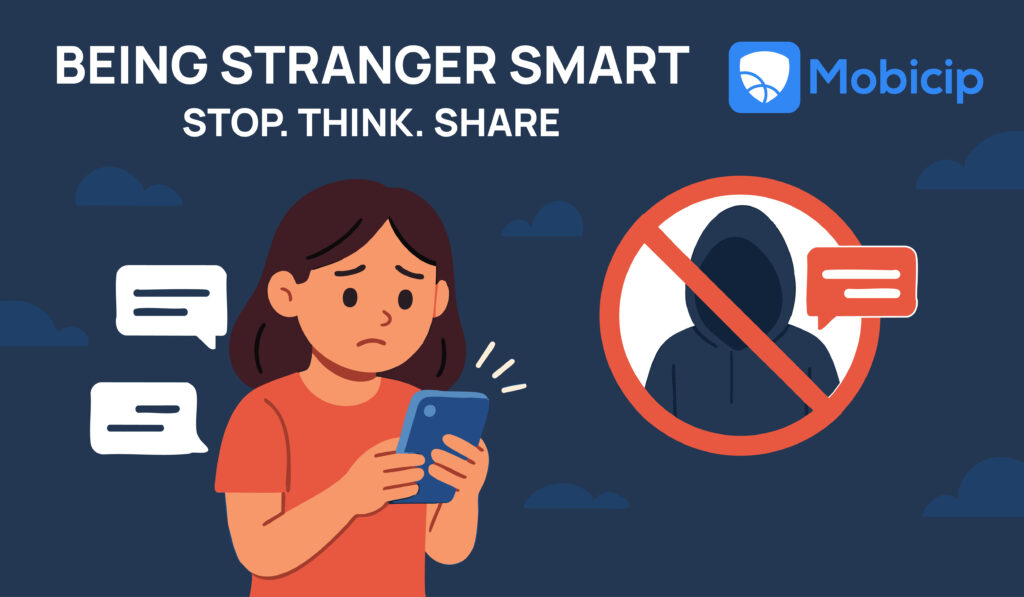How Parents Can Teach Their Kids About ‘Digital Stranger Danger’

Digital stranger danger refers to the risks children face when interacting with unknown people on the internet. Parents and guardians play a vital role in helping kids understand and manage these risks so they can stay safe while exploring the digital world.
Meeting strangers online can be just as risky as meeting them in real life—sometimes even more so, because people can easily hide their true identity behind a screen. From predators posing as children in gaming chats to scams, grooming, and exposure to harmful content, the dangers are real.
The good news is that awareness and guidance make a big difference. When children understand the risks, and when parents keep open conversations going, kids can learn to navigate digital spaces with confidence and care.
This is also where tools like Mobicip can help. With parental controls, safe browsing filters, and monitoring features, Mobicip empowers families to create safer online experiences.
In this post, we’ll look at why Jim Reeves’ song—“A stranger is just a friend you do not know”—no longer applies in today’s digital age, and explore practical ways parents can teach kids about digital stranger danger while building lasting habits of safety.
Why Digital Stranger Danger is Different (and Riskier)
Online interactions with strangers are not like meeting someone on the playground. The internet allows people to hide who they really are, making it easier for predators to blend in. Kids often assume that anyone chatting with them is a peer, but behind the screen, appearances can be deceptive. What starts as a normal conversation in a game, social app, or livestream can quickly escalate into risky situations.
Some key differences that make digital stranger danger especially risky:
- Anonymity: People can easily disguise their age, gender, or intentions.
- Persistence: Unlike a playground stranger who leaves, online predators can keep contacting a child repeatedly.
- Manipulation: Predators often use flattery, games, or gifts to gain trust and lower a child’s defenses.
- Wide access: One chat or livestream can reach dozens or even hundreds of children at once.
Even routine online interactions—friendly chats in multiplayer games, sharing photos in apps, or joining livestream comments—can become avenues for grooming, scams, or exposure to harmful content. Teaching kids to recognize subtle red flags, set boundaries, and communicate openly with parents or guardians is essential. Awareness and guidance can help children enjoy the digital world safely, without putting themselves at unnecessary risk.
Key Lessons Parents Can Teach Kids About Digital Stranger Danger
Kids don’t always realize how easily someone online can pretend to be their friend. As parents, we can guide them with simple, clear rules that keep them safe without making every screen moment feel scary.
Don’t Share Personal Info
Even small details can give someone more than they should know. Teach kids not to share their full name, school, address, or even things like their pet’s name. These might seem harmless, but predators can piece together enough information to find or manipulate them.
Recognize Manipulation Tactics
Predators often try to win trust through flattery, gifts, or “shared secrets.” Explain to kids that if someone online is making them feel special in a way that seems too good to be true, it might be a warning sign.
Trust Your Gut
Encourage children to pay attention to feelings. If a chat feels weird, confusing, or secretive, it’s okay to stop interacting. Their instincts are an important safety tool.
No Private Chats or Meetups
An online “friend” isn’t the same as a real friend. Make it clear that private messages, video calls, or meeting in person with someone they met online are off-limits.
Develop Trust
Reinforce that kids won’t get in trouble for asking for help. They should feel comfortable coming to you if anything online makes them uncomfortable, scared, or confused.
Make the Training Interactive (Role-Play & Analogies)
Learning about online safety doesn’t have to be all warnings and rules—it can be interactive and even a little fun. One of the best ways to teach kids is through practice and relatable comparisons. Here are some examples.
Friendly Stranger in a Game
- Parent pretends to be someone offering “free coins” or rewards.
- Child practices saying: “No thanks, I don’t accept gifts from people I don’t know.”
Asking Personal Questions
- Parent asks about school, pets, or favorite hangout spots.
- Child responds with safe answers or politely refuses: “I don’t share personal info online.”
Private Chat Invitation
- Parent asks to move the conversation to another app or video call.
- Child practices: “I only chat with people I know in real life.”
Secret-Sharing Trap
- Parent pretends to want a “secret” or private information.
- Child learns to recognize manipulation and say no: “I don’t share secrets online. I’ll tell my parent instead.”
Confusing or Weird Messages
- Parent sends a vague or strange message, like, “Hey, I know something about you…” or “Can you do me a small favor? Don’t tell anyone.”
- Child practices trusting their gut and walking away.
Repeated Contact
- Parent pretends to repeatedly ask for personal info or attention.
- Child learns to block, ignore, and report if necessary.
Tip for Parents
Praise your child after each scenario. Reinforce that it’s okay to say no, stop chatting, or come to you anytime something feels off.
Use Digital Protection Tools Together
Think of digital safety like learning a new game—you wouldn’t just hand your child a controller and walk away, right? Explore it together. Go through parental controls, privacy settings, or apps like Mobicip side by side. When kids see you actively participating, it becomes less about rules and more about teamwork.
- Explore parental controls, privacy settings, and safety apps with your child, so it feels collaborative, not controlling.
- Emphasize that the goal is empowerment, not surveillance—helping them make safe choices rather than just enforcing restrictions.
- Practice together: Try adjusting settings, blocking or reporting suspicious content, and reviewing privacy features as a team.
- Discuss why: Explain in simple terms why certain settings matter, like keeping personal information private or avoiding strangers online.
- Celebrate wins: When your child makes a smart online choice—like recognizing a suspicious message—acknowledge it. Positive reinforcement goes a long way.
- Keep learning: Technology changes fast. Make it a habit to revisit tools and settings regularly, showing that staying safe online is an ongoing process.
How Mobicip Helps Parents Keep Kids Safe Online
Mobicip makes protecting kids from digital stranger danger simple and collaborative. Instead of just enforcing rules, it empowers children to make smart choices online.
- Safe browsing filters: Keep harmful websites out of reach.
- App and game controls: Block risky chats and platforms.
- Screen time limits: Reduce exposure to unsafe interactions.
- Monitoring & reporting: See who your child is connecting with online.
- Location tracking: Extra peace of mind if online interactions ever go offline.

Stranger danger isn’t a “one and done” talk—it’s something to revisit regularly. Instead of a single long lecture, try short, bite-sized check-ins after gaming sessions or while scrolling together. Treat these chats like any other safety discussion, just as you would talk about seatbelts or crossing the street. By making digital safety a normal, ongoing conversation, children are more likely to feel comfortable sharing concerns and asking questions as they navigate the online world.

Conclusion
Teaching kids about digital stranger danger is really about nurturing confidence and curiosity at the same time. When children feel supported and listened to, they learn to explore online spaces thoughtfully, making decisions on their own while knowing they have a safety net. Every small conversation, practice session, or shared discovery builds their awareness and resilience. Over time, this guidance helps children become not just cautious, but empowered—capable of enjoying the digital world with a sense of freedom, responsibility, and trust in themselves.





